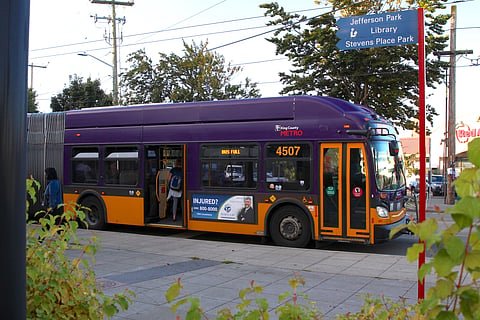King County Metro to Resume Collecting Fares Without Enforcement on October 1
by Jack Russillo
After suspending fares in March due to the COVID-19 pandemic, King County Metro will resume collecting fares on Thursday, October 1.
All county transit services — including buses, Access paratransit, Vanpool, and Via to Transit — will be requiring full fares. Fare collection is already taking place on Sound Transit Express buses and Link light rail. Like all Metro employees, Metro requires all riders to wear a face covering, as does Sound Transit. Per state public health guidelines, all trips should be for essential reasons only.
Metro has also suspended fare enforcement at least through the end of 2020. Fare enforcement officers will still be a presence around transit stops, but they will be providing a broader range of customer services, like answering transit or safety questions.
"We are really in honor of not contributing to breaking that six foot halo," said Terry White, King County Metro's Interim General Manager.
Metro is currently working with King County, King County Sheriff's Office, cities, and community stakeholders to implement alternatives to fare enforcement no later than 2022. The current contract with a private security firm to provide fare enforcement services is $4.7 million, according to King County.
Current ridership levels are down more than 60% compared to last year and the loss in fare collection revenue for Metro is an estimated $5.5 million per month.
"We remain diligent in working to ensure that these riders, these essential riders, that are still with us right now have the opportunity to remain mobile and provide these services to their work, whether that's groceries, medical, food, and those types of things," said Terry White, King County Metro's Interim General Manager. "We are being impacted, but we're working through that. Our commitment is to continue to make sure that there's mobility for the region."
In March, Metro halted fares and required that passengers enter and exit vehicles through rear doors to help protect passengers and operators from the potential spread of COVID-19. Boarding and exiting through the front doors will return on October 1. All Metro vehicles are disinfected daily, masks are required on all transit, and physical distancing is enforced by permitting only 12 or 18 riders at a time, depending on the size of the bus.
If a bus is not at capacity when it arrives at a stop, drivers will allow passengers to board even if the new passengers put the total number of riders over the limit. If a bus is full when it arrives at a stop, it will not stop to pick up more passengers until some riders ask to disembark and the bus is below capacity again. Drivers may show their bus is at capacity by switching the destination sign from the "Essential Trips Only" reminder to "Coach is Full, Sorry" or "Bus Full."
There is only one ADA priority seat on each bus, which does contribute to the overall number of passengers. If the ADA seating area is empty, a rider needing that space is allowed to board. Customers with disabilities whose essential travel needs are not being met can also use Metro's Access paratransit service. They can call 206-205-5000 for assistance.
When paying fares, King County Executive Dow Constantine is encouraging riders to use a contactless payment option — like an ORCA card or ORCA LIFT card — to speed up the boarding process and further protect themselves and the operators. Fares can still be paid in cash.
"The ORCA card expedites boarding [and] makes it safer for everyone," said Constantine in early September when Metro announced the new safety features.
Metro has also implemented new health innovations for riders and operators, such as transparent partitions on buses, Access paratransit, Community Ride, Community Van, DART, Via to Transit, and water taxis.
Jack Russillo has been reporting in Western Washington since 2013. He covers the environment, social justice, and other topics that affect a sustainable and equitable future. He currently lives in Seattle's Beacon Hill neighborhood.
Featured image: A bus finishes loading passengers outside of the Beacon Hill light rail station. (Photo: Jack Russillo)
Help keep BIPOC-led, community-powered journalism free — become a Rainmaker today.


